
Back جرجنت Arabic اجريجنتو ARZ Agrigento AVK Aqricento Azerbaijani Агрыджэнта Byelorussian Агридженто Bulgarian Agrigento Breton Agrigent Catalan Агридженто CE Agrigento (munisipyo) CEB
You can help expand this article with text translated from the corresponding article in Italian. (January 2022) Click [show] for important translation instructions.
|
Agrigento
| |
|---|---|
| Comune di Agrigento | |
 Agrigento as seen from the Valley of the Temples. | |
| Motto: Signat Agrigentum mirabilis aula gigantum | |
| Coordinates: 37°19′N 13°35′E / 37.317°N 13.583°E | |
| Country | Italy |
| Region | Sicily |
| Province | Agrigento (AG) |
| Frazioni | Fontanelle, Giardina Gallotti, Monserrato, Montaperto, San Leone, Villaggio La Loggia, Villaggio Mosè, Villaggio Peruzzo, Villaseta |
| Government | |
| • Mayor | Francesco Miccichè (Ind) |
| Area | |
| • Total | 245.32 km2 (94.72 sq mi) |
| Elevation | 230 m (750 ft) |
| Population (31 March 2016)[2] | |
| • Total | 59,791 |
| • Density | 240/km2 (630/sq mi) |
| Demonyms | Agrigentines or Girgintans agrigentini or girgentini (Italian) giurgintani (Sicilian) |
| Time zone | UTC+1 (CET) |
| • Summer (DST) | UTC+2 (CEST) |
| Postal code | 92100 |
| Dialing code | 0922 |
| Patron saint | St. Gerland (Gerlando) |
| Saint day | 25 February |
| Website | Official website |
Agrigento (Italian: [aɡriˈdʒɛnto] ; Sicilian: Girgenti [dʒɪɾˈdʒɛndɪ] or Giurgenti [dʒʊɾˈdʒɛndɪ]; Ancient Greek: Ἀκράγας, romanized: Akrágas; Latin: Agrigentum or Acragas; Punic: ’GRGNT; Arabic: كركنت, romanized: Kirkant, or جرجنت Jirjant) is a city on the southern coast of Sicily, Italy and capital of the province of Agrigento.
Founded around 582 BC by Greek colonists from Gela,[3] Agrigento, then known as Akragas, was one of the leading cities during the golden age of Ancient Greece.[4][5][6][7][8] The city flourished under Theron's leadership in the 5th century BC, marked by ambitious public works and the construction of renowned temples.[9]
Despite periods of dormancy during the Punic Wars, Agrigento emerged as one of Sicily's largest cities in the Republican era. During the Principate, Agrigento's strategic port and diverse economic ventures, including sulfur mining, trade and agriculture, sustained its importance throughout the high and late Empire. Economic prosperity persisted in the 3rd to 4th centuries AD, but excavations show decline in activity after the 7th century.[9]
- ^ "Superficie di Comuni Province e Regioni italiane al 9 ottobre 2011". Italian National Institute of Statistics. Retrieved 16 March 2019.
- ^ "Popolazione Residente al 1° Gennaio 2018". Italian National Institute of Statistics. Retrieved 16 March 2019.
- ^ Bagnall, Roger S.; Brodersen, Kai; Champion, Craige B.; Erskine, Andrew; Huebner, Sabine R., eds. (2013-01-30). "Akragas (Agrigentum)". The Encyclopedia of Ancient History (1 ed.). Wiley. doi:10.1002/9781444338386.wbeah16002. ISBN 978-1-4051-7935-5.
- ^ Hooke, N. (1818). The Roman history, from the building of Rome to the ruin of the commonwealth... New ed. Printed for F.C. and J. Rivington. p. 17. Retrieved 2014-10-10.
- ^ Lemprière, J. (1842). A Classical Dictionary: Containing a Full Account of All the Proper Names Mentioned in Ancient Authors, with Tables of Coins, Weights, and Measures, in Use Among the Greeks and Romans. To which is Now Prefixed, a Chronological Table. T. Allman. p. 26. Retrieved 2014-10-10.
- ^ Royal Institution of Great Britain (1828). Quarterly Journal of Science, Literature, and the Arts. James Eastburn. p. 98. Retrieved 2014-10-10.
- ^ Maynard, J. (2005). The Light of Alexandria. Lulu Enterprises Incorporated. p. 35. ISBN 9781411653351. Retrieved 2014-10-10.
- ^ Rollin, C.; Bell, J. (1870). The ancient history of the Egyptians, Carthaginians, Assyrians, Babylonians, Medes and Persians, Grecians and Macedonians: including a history of the arts and sciences of the ancients. Harper & Brothers. p. 286. Retrieved 2014-10-10.
- ^ a b Pfuntner, Laura (2019-01-07), 3. The Southwestern Coast: Economic Integration, Political Privilege, and Urban Survival, University of Texas Press, pp. 107–122, doi:10.7560/317228-005, ISBN 978-1-4773-1723-5, S2CID 241124857, retrieved 2024-02-08
© MMXXIII Rich X Search. We shall prevail. All rights reserved. Rich X Search




